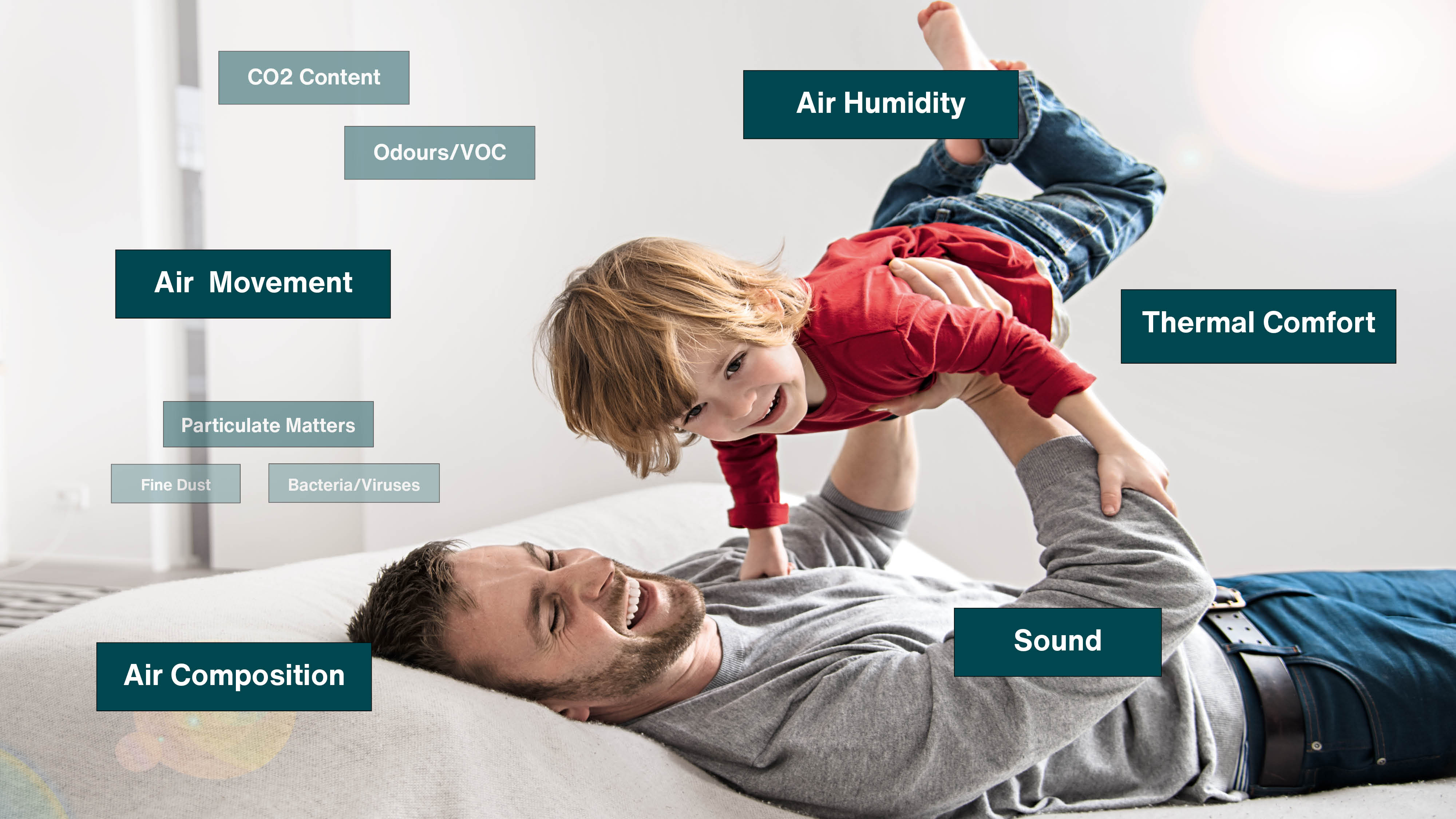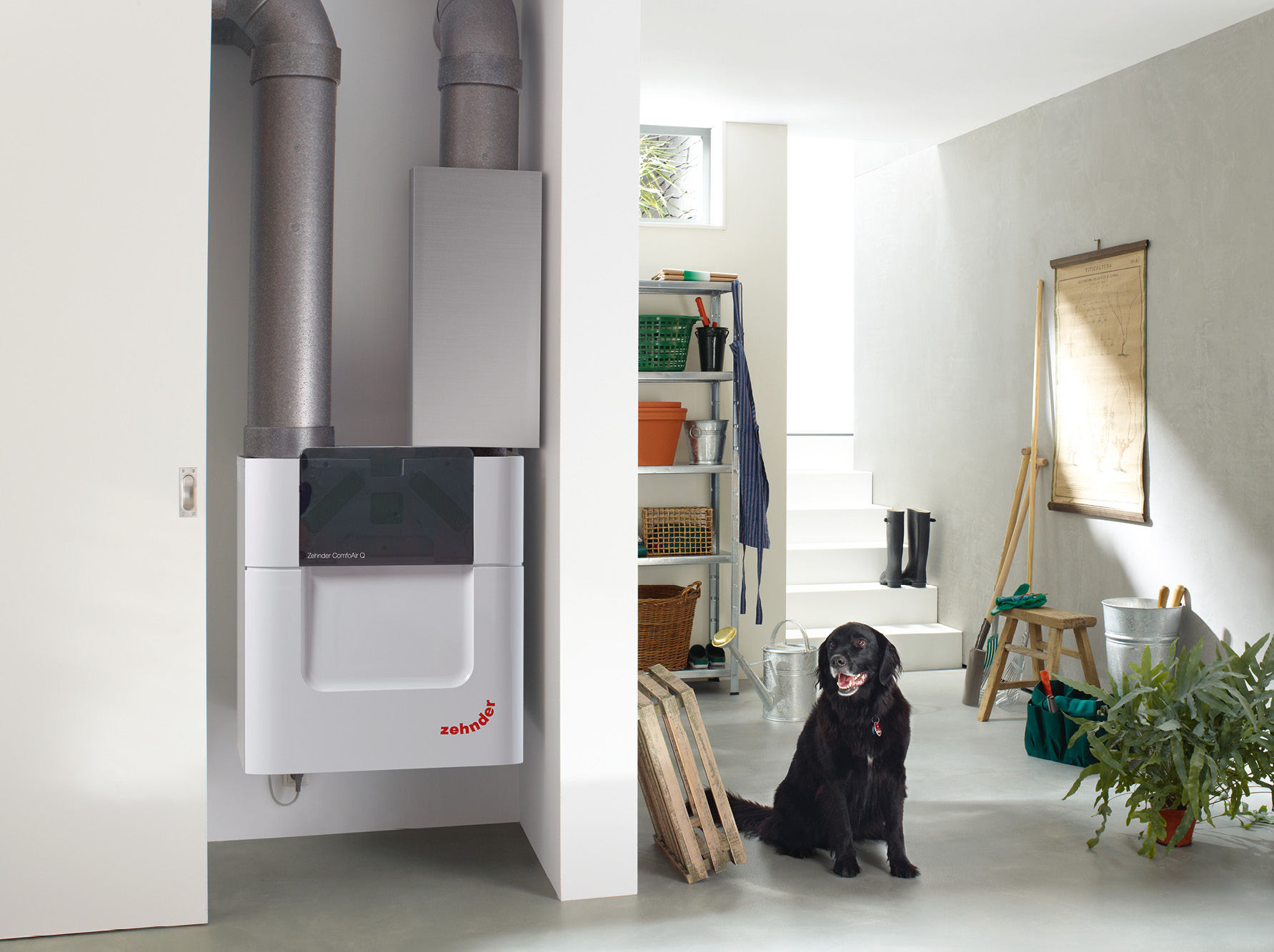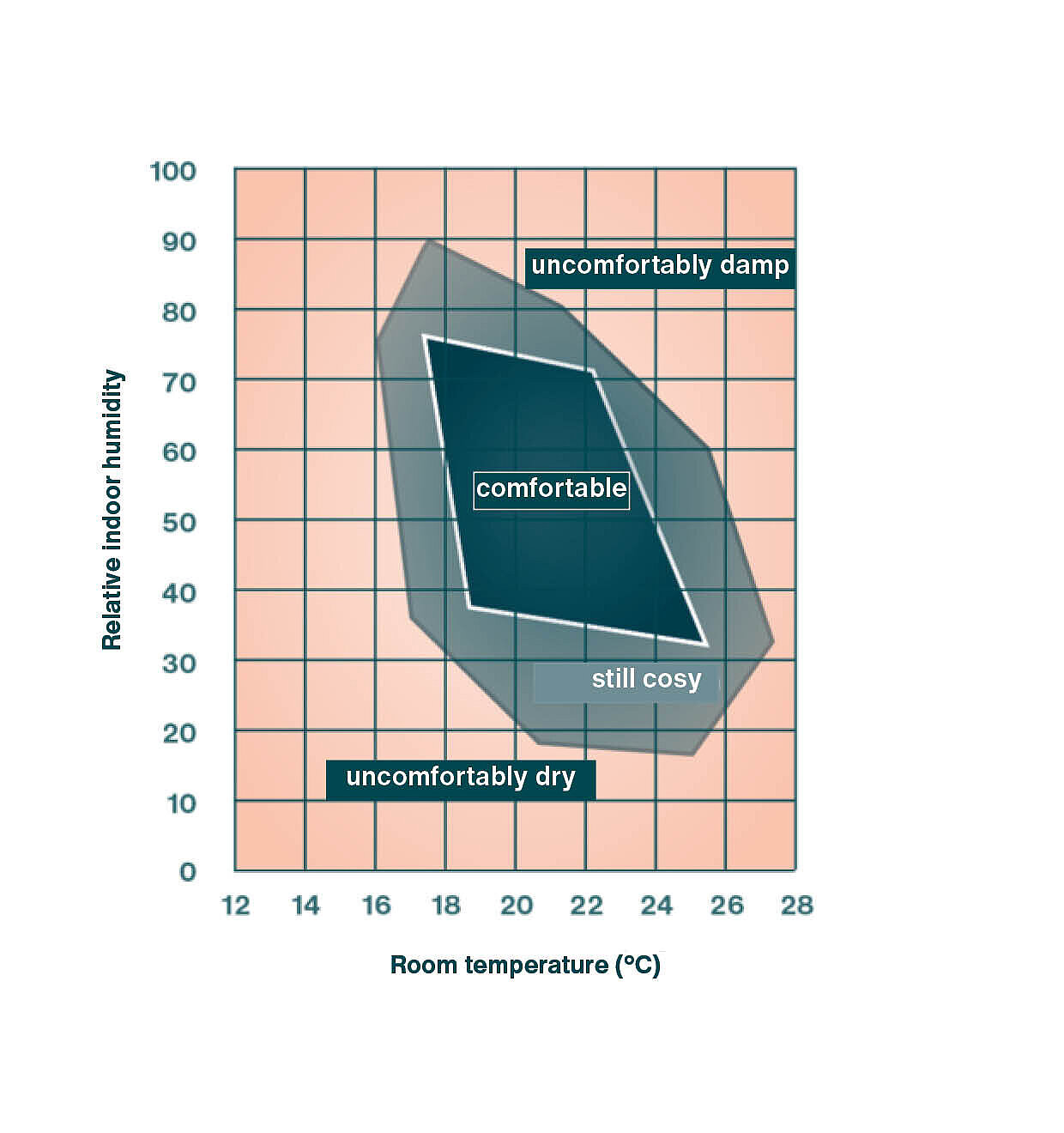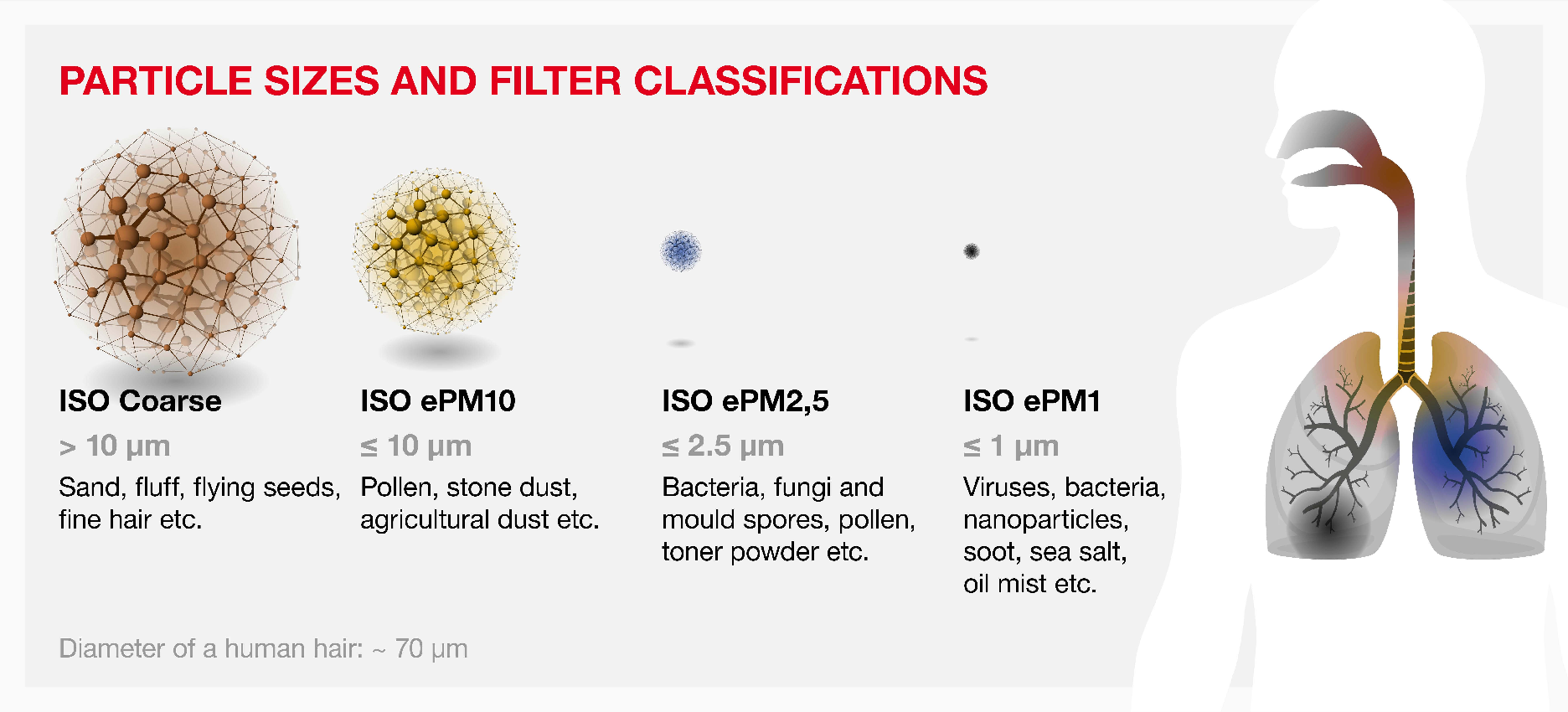Healthy indoor climate
What factors influence the feel-good climate in the home?
Air - initially inconspicuous, shapeless and intangible. Yet we breathe 15 to 100 kg of this gaseous substance every day. Compared to approx. 0.5 kg of solid food and around 1 to 1.5 kg of liquid, which cover a person's daily needs, the air we breathe is the most important food. Humans can survive for around three weeks without food, around three days without drinking water and only around three minutes without breathing.
Read on to discover the many aspects of breathing air and find out how it can affect human health.

Air composition
Air consists of around 78% nitrogen, around 21% oxygen and a small amount of various trace gases. The air is also a carrier of fine dust, particles, viruses, bacteria and odours.
Thermal comfort
Thermal comfort describes how comfortable a person feels in a room in terms of temperature and relative humidity. Comfort ventilation creates the ideal conditions for creating a pleasant indoor climate all year round.
Sound
A controlled mechanical ventilation is equipped with a motor that generates vibrations that move air. This produces sound waves that generate noise. The fans in a Zehnder ventilation system are therefore installed inside a soundproof enclosure. In this way, the devices are very quiet during operation and there is no annoying noise emission into the home environment.
Air humidity
For energy reasons, people are building and renovating more and more compactly. This means that there is no longer any natural air circulation through windows or cracks. In summer, this can lead to a build-up of moisture in rooms and the formation of mould. Conversely, during the winter heating period, the air can become too dry, causing problems. A ventilation system solves this problem by continuously regulating the air humidity.
Air movement
With a comfort ventilation system, air exchange takes place continuously and slowly, so that draughts are avoided and the amount of dust raised is reduced compared to window ventilation.
Would you like to achieve a healthy and comfortable indoor climate in your own home?
There are few things more important than the air we breathe. With a ventilation system, you can minimise the CO2 content and volatile organic compounds and thus ensure maximum air quality and healthy living - regardless of the size of the property and regardless of whether it is a new build or a renovation.
Not stuffy, odourless, at a pleasant temperature and not too dry: these are the primary requirements for a pleasant indoor climate. In detail, healthy indoor air also means that it is as free as possible from pollutants and fine dust, has low chemical emissions such as VOCs (volatile organic compounds) and formaldehyde, prevents the spread of harmful bacteria as far as possible and has a low CO2 content. In short: clean, oxygen-rich, fresh air.
There is a suitable ventilation system for all requirements, regardless of whether you want single-room ventilation, inexpensive basic ventilation or sophisticated comfort ventilation - even with a cooling system on top. Find out where a ventilation system makes sense and which design could be of interest to you.
This is how indoor air should be ...

Healthy indoor air in the home is important for our well-being and health. An optimal indoor climate can be measured by the following factors:
- Temperature
21 - 26°C - Humidity
30 - 60 % relative humidity - Vertical temperature difference between ceiling and floor
maximum 2 - 3°C - Air movement (draught)
maximum 0.1 m/s (bei 20°C) bis 0.5 m/s (bei 26°C) - CO2-concentration
maximum 1000 - 1300 ppm (outside air has about 400 ppm) - Noise emissions
maximum 25 - 30 dBA - Odours
none - Particulate matter
maximum 20 - 50 μg/m³ - Pollen
none - Radon
maximum 300 Bq/m³
Air flow
Draughts caused by open windows or leaking façades are perceived as unpleasant by most people, especially at low temperatures. According to a study by the Swiss Federal Office of Energy, around 60% of residents with simple exhaust air systems (no comfort ventilation) "sometimes or always feel draughts" near the outside air vents.
With tight building envelopes, comfort ventilation controls the air intake, the air velocity and the air temperature, thereby ensuring a pleasant indoor climate without disruptive factors.

Humidity
Indoor air that is too dry during the heating period? Not with Zehnder!
Indoor air is often too dry, especially on cold winter days. This can lead to unpleasant irritation.
The Zehnder enthalpy exchanger in the ventilation unit provides a remedy thanks to a highly efficient polymer membrane film. The heat and moisture exchanger can recover the moisture from the extract air in a hygienically perfect manner.

Winter phenomenon "dry indoor air"
The optimum relative humidity is around 45% and is an important factor for well-being and health. Particularly on cold winter days, the air in a room can dry out quickly if it is aired out. If the humidity falls below 30%, unpleasant irritation symptoms and even health problems can be expected. The mucous membranes in the mouth and nose dry out, weakening the human defence system.
Humidity in the home not only plays a role in our well-being, it also affects the materials used in interior design and even the fabric of the building (e.g. parquet floors).
Good to know
When rooms are ventilated, cold outside air enters the heated rooms. Cold outside air at 0°C can absorb four times less water vapour than at 21°C. Even if the outside air has 100% relative humidity at 0°C because it is snowing or raining, this value drops to just 26% when it warms up to 21°C.
Sound
No sound transmission
Air distribution is very quiet thanks to upstream silencers in the supply and return air ducts. Sound transmission from room to room is eliminated as each air diffuser is connected individually to the distribution boxes.
Another advantage is that residential ventilation can also protect against noise from outside. On a busy main road, for example, the ventilation system continuously provides fresh air without the noise of the road being audible through open windows and doors.

Thermal comfort
Thermal comfort describes how comfortable a person feels in a room in terms of temperature and relative humidity. Comfort ventilation creates the optimum conditions for creating a pleasant indoor climate all year round.
Although well-being is subjective, the general comfort range extends from around 18 °C to 24 °C and 35 % to 75 % relative humidity RH. People cannot distinguish 30% RH from 50% RH, or can only do so in rare cases. Excessive humidity, e.g. in summer (with cooled indoor air) or in winter (with poor insulation) can lead to mould growth. This condition can not only have negative health consequences (allergies, infections, asthma) but can also cause massive damage to the building fabric.

Composition of air
CO2 content
The CO2 content should be monitored in living and office spaces. With normal occupancy, the value of 1400 ppm must never be exceeded. It is virtually impossible to maintain this value with window ventilation.
Viruses
The FOPH explicitly recommends a permanent and sufficient supply of fresh air, regardless of whether this is provided by mechanical ventilation or window ventilation. Comfort ventilation is the only ventilation system that enables a regular exchange of air in residential buildings. It brings fresh outside air into the room and removes any contaminated inside air. This reduces the viral load in the air we breathe.
Particulate matter and bacteria
Air pollution is a proven cause of illness - especially excessive exposure to particulate matter. The filtering effect of the nasopharynx is not sufficient for fine particles with a diameter of less than 10 micrometres. The smaller the particles are, the deeper they can penetrate into the lungs. The high-performance filters contained in a comfort ventilation system easily capture fine dust and even smaller fine particles such as bacteria (ePM10).
Odours
Stale air and unpleasant odours are removed from the ventilation system via the exhaust air. This keeps the air fresh and the CO2 content in the air low - for better concentration and greater well-being.
Improved air quality
In normal operation, a complete room air exchange takes place approximately every 2 hours with comfort ventilation. Comfort ventilation is well suited to removing human pollutants (e.g. CO2) or unwanted odours and can also significantly minimise emissions from building materials, surfaces and furniture (e.g. formaldehyde) in the air.



What you should know about comfort ventilation.
Less heat loss
With a ventilation system, the heat loss is more than two thirds lower than when ventilating through the windows.
Healthy indoor air
Ventilation systems constantly provide good, healthy air in the house and remove excess moisture, which can lead to mould growth.
Indoor air not too dry
In winter, ventilation systems with humidity recovery ensure that the air does not become too dry.
Lower risk of infection
Regular air exchange reduces the risk of pathogens such as viruses and bacteria being transmitted via the air.
Source: energieschweiz




